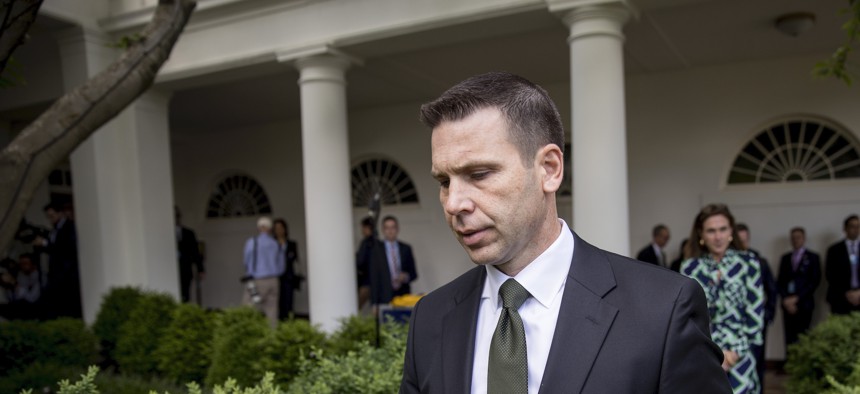
Acting Homeland Security Secretary Kevin McAleenan arrives for an immigration speech by President Donald Trump in the Rose Garden at the White House, Thursday, May 16, 2019. AP Photo/Andrew Harnik
DHS Is Finally Going After White Supremacists. That Won't Be Simple.
A new strategy prioritizes domestic terrorism, especially of the extreme right. Now the agency has to actually tackle the problem.
Kevin McAleenan took the El Paso shooting personally. The acting secretary of the Department of Homeland Security had visited the city more than a dozen times. He recalled in a Thursday interview that among his first thoughts were the safety of the DHS workforce, which numbers some 4,000 people there, many of them Hispanic.
The shooter’s motivation quickly became clear, with 22 people dead in a Walmart and an online manifesto attributed to the shooter citing an “invasion” of immigrants. “This,” McAleenan recalls thinking, “was an attack on all of us, on our family.” Speaking to The Atlantic more than six weeks after the attack, he had an “El Paso Strong” bracelet on his wrist.
The El Paso shooting figures into a new strategy to counter terrorism and “targeted violence” that the Department of Homeland Security will release today, which The Atlantic obtained and describes here for the first time. The document dwells at length on the threat of white supremacists specifically, which is surprising coming from President Donald Trump’s administration, given that one of its first counterterrorism policies was to try to ban citizens from seven Muslim-majority countries. Trump has also pushed for a border wall, which he has said will help keep out terrorists, even though most fatal terrorist attacks in the United States in recent years have been carried out by U.S. citizens or permanent residents. The DHS document is an acknowledgment that, nearly 20 years after 9/11, the new terrorist threat comes largely from within—and not as much from jihadists as from the extreme right.
The department is clearly trying to send a message that it takes the threat of violent white nationalists seriously, and McAleenan said that when leadership lays out its goals, bureaucracies tend to move.
If DHS get everything it wants, it will have more resources to analyze the changing nature of terrorism in the U.S.; improve information-sharing with local law enforcement; and provide training to communities to prevent or respond to attacks, including through active-shooter drills and security in schools, McAleenan told me. He said the department’s existing resources can be redistributed to better coordinate and focus the sprawling counterterrorism bureaucracy on a wide range of threats, from online radicalization to the movement of weapons of mass destruction. But as with any plan, this one faces obstacles to implementation.
The fact that many of the recommendations in the document call for further study indicates just how poorly the federal government understands the problem of white-supremacist violence and its scope. Public statistics show that white supremacists now represent the deadliest extremists in the United States—for instance, the Anti-Defamation League has reported that last year, white supremacists perpetrated 39 of 50 domestic extremism-related killings in the United States. (The same year saw only one death linked to jihadist terrorism in the U.S.) Yet at the federal level, statistics are imperfect and unevenly reported; the ADL also notes that more than 1,000 law-enforcement agencies didn’t reporttheir data on hate crimes to the FBI, leaving huge gaps in the nationwide picture.
Related: DHS’s New Counterterrorism Strategy Reflects Professionalism, Not Politics
Related: The Fight Against White Nationalism Is Different
Related: How White-Supremacist Violence Echoes Other Forms of Terrorism
Preventing violence, no matter the motivating ideology, is a difficult and imperfect process—not least in a society that protects hate speech as well as access to guns. McAleenan serves in an acting capacity; a permanent successor might not share the same priorities. Then there is the matter of money; some of the very same kinds of programs DHS now wants to expand have seen budget and personnel cuts throughout the Trump administration.
“I think there is the appropriate callout for white-supremacist and other targeted-violence actors in this strategy,” George Selim, a former DHS official who ran violent-extremism-prevention programs and resigned two years ago, told me. His concern is that “it’s not clear what the means of execution and resources are.” Selim, who now works as senior vice president of programs at the Anti-Defamation League, wrote earlier this year that his former office had been “gutted” of money and people in the past three years. He argued that the administration was hobbling the country’s ability to meet the threat of violent extremism.
Neither ISIS nor al-Qaeda is yet vanquished either, and they remain priorities for the department despite efforts to pay more attention to other ideological actors, and even violence motivated by no ideology in particular, such as the Sandy Hook school shooting. McAleenan noted the problem of people returning to the U.S. after fighting in Syria, and said the department can’t lose focus on what he says has worked in the past against jihadist terrorism. “We’ve prevented another 9/11,” he said.
DHS is now trying to correct gaps in its understanding of terrorist threats, calling for, among other things, an annual report “evaluating the domestic threat environment.” This is important, Selim said, but the fact that no such report yet exists shows that the government is already behind. “We’ve lost significant time that could have been devoted to studying the behavioral and social issues that motivate domestic violent extremists.”
The problem of extremist violence, no matter the ideology, is also one that runs up against the first two amendments of the U.S. Constitution. Communications technologies can help connect extremists in communities, where they encourage and feed off one another, even inspiring or facilitating the planning of attacks. Guns are easy to get and hard to regulate. Preventing violence often involves trying to predict it—and right up to the moment of an attack, any “warning sign,” such as a racist social-media post, can just as easily be a false positive. That’s assuming such a sign comes in time to do anything about it; the El Paso attacker posted his manifesto about 18 minutes before he started shooting.
And as the document acknowledges, holding extremist beliefs is not a crime, so there are limits to what law enforcement can do when it comes to prevention. (As FBI Director Christopher Wray told Congress this summer: “We, the FBI, don’t investigate ideology, no matter how repugnant. When it turns to violence, we’re all over it.”) Hence the document’s emphasis on community partnerships and “off-ramps” such as counseling for people seen as at-risk. The success of such programs will be difficult to measure—how do you count attacks that haven’t happened?
These are all practical challenges that DHS officials are well aware of. There are also political challenges. There is growing bipartisan consensus that right-wing extremism, including white-supremacist violence, is a problem that merits urgent attention. Trump, who was condemned as equivocating about “good people on both sides” after a white-supremacist rally in Charlottesville, Virginia, in which a counterprotester was killed, condemned hatred and bigotry after the El Paso shooting. Trump’s National Security Council for the first time identified nationalist and neo-Nazi groups as a terrorist threat in its own strategy last year. Notably, however, the shooter’s manifesto used the same language the president has in the past used about an “invasion” of immigrants, though it also specified that his views predated the Trump administration.
Yet a previous DHS effort in 2009 to simply describe the problem of right-wing extremism faced condemnation from conservative and veterans’ groups, who accused the report’s authors of stigmatizing legitimate political beliefs. In the end, the Homeland Security secretary, Obama appointee Janet Napolitano, had the report pulled from DHS websites. The analyst responsible saw his unit disbanded and left the agency.
McAleenan said he’s not worried about the potential for political backlash. “We’re worried about threats to the American people,” he said.
Another challenge may be Trump himself, who has been accused of emboldening the far right with rhetoric that demonizes immigrants, and with extreme policies—including the separation of migrant families, also undertaken by DHS—to keep them out. McAleenan and other DHS officials said the White House was supportive of the strategy. Asked whether the president’s rhetoric was harmful, one official, speaking on background near the end of an interview, would only say: “We’ll defer back to the White House on that one. Thank you for your time.”
Yara Bayoumy contributed reporting to this article.




